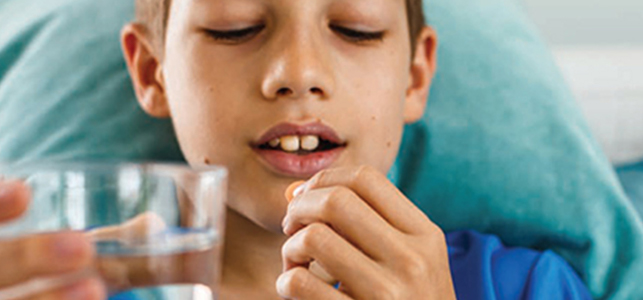
Your child has been prescribed opioids, now what?
Opioids have gotten a lot of attention recently, and rightfully so. They can be addictive and lead to negative consequences when not used properly.
For short-term use, such as after surgery, opioids can be effective at reducing severe pain. With continued use, people can develop a tolerance to opioids requiring higher doses to achieve the same effects. As soon as your child’s pain begins to lessen, they should decrease to smaller doses based on the doctor’s instructions, and then to over-the-counter pain relievers – or other medications as guided by their doctor.
Doctors and pharmacists throughout the state have access to a centralized database for reviewing and assessing controlled substances. Our team uses this tool before writing and filling prescriptions to help prevent duplicate prescriptions and ensure safe amounts of controlled substances are prescribed. There are safety measures you can take at home too!
How can you help keep your child safe when taking opioids?
 If your child has had a surgical procedure or other occurrence resulting in severe pain, they may be prescribed an opioid, such as oxycodone, hydrocodone, morphine or hydromorphone.
If your child has had a surgical procedure or other occurrence resulting in severe pain, they may be prescribed an opioid, such as oxycodone, hydrocodone, morphine or hydromorphone.
- Make sure medications are taken correctly and follow all instructions from your doctor or pharmacist.
- Prescribed medications, especially opioids, should not be shared with anyone, including family members.
- Do not save unused or expired opioid medications.
Store opioids safely
It’s important to keep opioids in your home only for the period of time they are being used as medically directed. During this time, make sure you’re keeping everyone in the home safe by storing them properly.
- Opioids should be stored in their original packaging, so it’s clear for whom the medications are prescribed and how they should be taken.
- Keep childproof caps on the containers.
- Opioids should be stored in a locked cabinet, lockbox or other secure location to avoid access by others, and especially out of the reach of children.
- Note: The bathroom is the worst place to store medications of any kind. The moisture from the bathroom can alter their effectiveness.
Safely discard unused opioids
Once your child no longer needs their opioid medications, dispose of them safely.
- Do not flush medications down the sink or toilet unless the medication label instructs you to do so.
- Instructions for disposal can sometimes be found on the prescription label or patient information leaflet. If no disposal instructions are provided, there are several options to discard unused or old medications.
- Local pharmacies, such as our Children’s Pavilion Pharmacy, have drug take back boxes where you can easily drop off old or unused medications. Visit the Virginia Board of Pharmacy website for other specific locations.
- Local police stations have drug take back programs. Check with your local police department for details.
- If you don’t have access to the above disposal locations, you can dispose at home by: (1) removing or using a marker to black out personal information on the container, (2) mixing the unused drugs with coffee grounds, dirt or kitty litter and (3) placing them in a sealed container and throwing in the trash.
Medicine safety – a pharmacist’s tips
All types of medication can be dangerous for kids if not used properly. Keep these tips in mind before giving your child’s next dose.
- Cereal, soup and cooking spoons should NOT be used for medicine. To ensure accuracy, use a medication measuring cup or medication oral syringe provided by the pharmacy with the prescription.
- Pay close attention when purchasing over-the-counter medication. Pediatric medications often have different dosage strengths and formulas than the adult versions, so they’re not interchangeable.
- Read the labels carefully for instructions on how to give the medicine (should it be shaken first, taken with or without food, etc.). Labels also provide important information on side effects to look out for after giving your child medication.
- Double check medications before giving them to your child. Everyone is busy these days and it can be easy to grab the wrong container, especially since many prescription bottles look the same.
- If your child vomits or spits out part of the medicine, call the doctor or pharmacist to see if you should give another dose.
- If your little one has trouble swallowing a pill, check with the pharmacist to see if it’s safe to crush and mix it with applesauce or pudding. They’ll need to eat it all to make sure they get their full dose of medicine.
Consider choosing a pediatric-focused pharmacy for your child’s prescriptions, when possible. The pharmacist will be very familiar with pediatric doses and can provide accurate measuring devices. They’re also great at helping parents figure out the best way to give medicine to kids – from offering flavoring options (like chocolate or cherry!), to switching to a chewable tablet and recommending tried and true tips for kids of all ages.
By Kelley Byrum, PharmD, BCPPS and Natalie Nguyen, PharmD, MSHA, pediatric pharmacists
